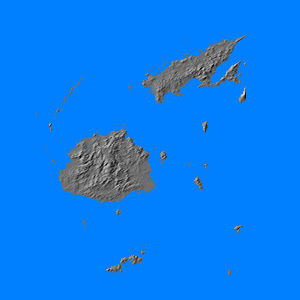![]() The Pacific War Online Encyclopedia
The Pacific War Online Encyclopedia
|
| Previous: Fighters | Table of Contents | Next: Fiji Class, British Light Cruisers |

Fiji is a large island group in southwest Polynesia, located 1300 miles (2100 km) north of New Zealand's North Island and close to the International Date Line. There are over 250 islands in the group, of which about 80 were inhabited in 1940, with a total area of about 7000 square miles (18,000 km2). The largest islands are Viti Levu, with most of the population, and Vanua Levu, and there were another 26 islands with areas in excess of 5 square miles (13 km2). Most of the islands are mountainous, with rugged terrain reaching to 4000' (1200 meters) on the largest two islands. However, the coastal plains are well watered and fertile. The islands have fringing reefs and few beaches, making them poor targets for amphibious assault. The climate is dominatd by the trade winds, with the east coasts of the island receiving 100-120 inches (250-300 cm) of rainfall per year, mostly in November to March, while the west coasts receive just 65 to 70 inches (165 to 178 cm) of rain per year and are very dry April to October. Temperatures vary from 62F to 92F (17C to 33C) with high humidity. The islands were free of malaria and most other tropical diseases. Vegetation consisted of jungle on the east coasts and grass and scrub on the drier west coasts.
The islands were a cultural crossroads and the native Fijians were a
mixture of Melanesian, Micronesian, and Polynesians. Early British explorers described
them as split into warring factions who practiced ritual cannibalism.
The British sought to unite the factions under a single king in August
1871, and when this failed, the islands were annexed as a crown colony
on 10 October 1871. The British prohibited sale of native land to
Europeans but brought in large numbers of Indian
laborers to work the sugar fields.
Small amounts of copra and rubber were also produced. By 1941 the
Indians, granted equal rights with Europeans in 1937, had largely taken
over the sugar industry. Gold was
discovered on northern Viti Levu in 1932.
The population was about 4300 Europeans, 104,900
native Fijians, 98,100 Indians, 2100
Chinese, and about 11,400 from other
parts of the Pacific or of mixed ancestry. There were significant
military facilities in place when war broke out in the Pacific, almost
all located on Viti Levu. Though the population was not large,
it contributed some of
the toughest troops that fought in the Pacific. The Fiji
Defense Force reached a
peak of 8000 men, mostly Fijians or persons of mixed Fijian-European
ancestry.
Ethnic Indians were excluded for political reasons. About
2500 of these troops
saw combat in the Solomon
Islands, where
their exploits as scouts became legendary.
References
Vatukoula
Gold Mine Website (accessed 2010-7-24)
The Pacific War Online Encyclopedia © 2007, 2010 by Kent G. Budge. Index